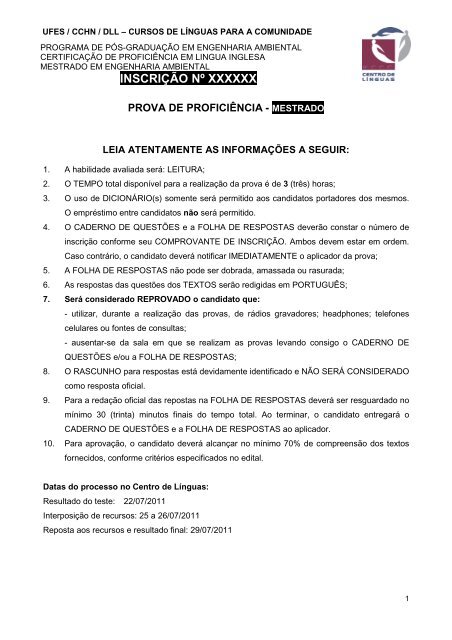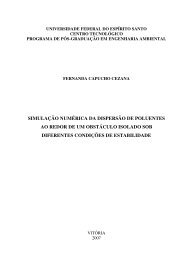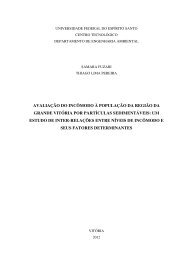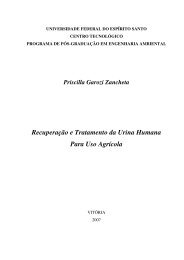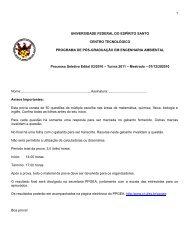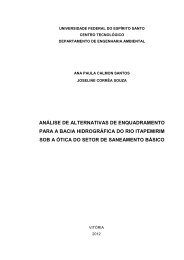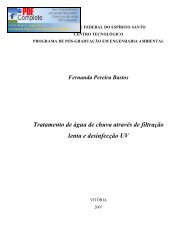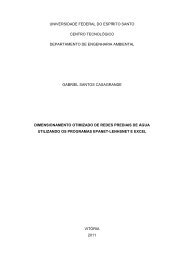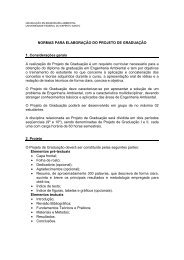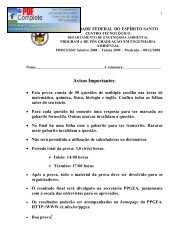PROVA ENG AMB MESTRADO - Centro Tecnológico / UFES
PROVA ENG AMB MESTRADO - Centro Tecnológico / UFES
PROVA ENG AMB MESTRADO - Centro Tecnológico / UFES
You also want an ePaper? Increase the reach of your titles
YUMPU automatically turns print PDFs into web optimized ePapers that Google loves.
<strong>UFES</strong> / CCHN / DLL – CURSOS DE LÍNGUAS PARA A COMUNIDADE<br />
PROGRAMA DE PÓS-GRADUAÇÃO EM <strong>ENG</strong>ENHARIA <strong>AMB</strong>IENTAL<br />
CERTIFICAÇÃO DE PROFICIÊNCIA EM LINGUA INGLESA<br />
<strong>MESTRADO</strong> EM <strong>ENG</strong>ENHARIA <strong>AMB</strong>IENTAL<br />
INSCRIÇÃO Nº XXXXXX<br />
<strong>PROVA</strong> DE PROFICIÊNCIA - <strong>MESTRADO</strong><br />
LEIA ATENTAMENTE AS INFORMAÇÕES A SEGUIR:<br />
1. A habilidade avaliada será: LEITURA;<br />
2. O TEMPO total disponível para a realização da prova é de 3 (três) horas;<br />
3. O uso de DICIONÁRIO(s) somente será permitido aos candidatos portadores dos mesmos.<br />
O empréstimo entre candidatos não será permitido.<br />
4. O CADERNO DE QUESTÕES e a FOLHA DE RESPOSTAS deverão constar o número de<br />
inscrição conforme seu COM<strong>PROVA</strong>NTE DE INSCRIÇÃO. Ambos devem estar em ordem.<br />
Caso contrário, o candidato deverá notificar IMEDIATAMENTE o aplicador da prova;<br />
5. A FOLHA DE RESPOSTAS não pode ser dobrada, amassada ou rasurada;<br />
6. As respostas das questões dos TEXTOS serão redigidas em PORTUGUÊS;<br />
7. Será considerado RE<strong>PROVA</strong>DO o candidato que:<br />
- utilizar, durante a realização das provas, de rádios gravadores; headphones; telefones<br />
celulares ou fontes de consultas;<br />
- ausentar-se da sala em que se realizam as provas levando consigo o CADERNO DE<br />
QUESTÕES e/ou a FOLHA DE RESPOSTAS;<br />
8. O RASCUNHO para respostas está devidamente identificado e NÃO SERÁ CONSIDERADO<br />
como resposta oficial.<br />
9. Para a redação oficial das repostas na FOLHA DE RESPOSTAS deverá ser resguardado no<br />
mínimo 30 (trinta) minutos finais do tempo total. Ao terminar, o candidato entregará o<br />
CADERNO DE QUESTÕES e a FOLHA DE RESPOSTAS ao aplicador.<br />
10. Para aprovação, o candidato deverá alcançar no mínimo 70% de compreensão dos textos<br />
fornecidos, conforme critérios especificados no edital.<br />
Datas do processo no <strong>Centro</strong> de Línguas:<br />
Resultado do teste: 22/07/2011<br />
Interposição de recursos: 25 a 26/07/2011<br />
Reposta aos recursos e resultado final: 29/07/2011<br />
1
<strong>UFES</strong> / CCHN / DLL – CURSOS DE LÍNGUAS PARA A COMUNIDADE<br />
PROGRAMA DE PÓS-GRADUAÇÃO EM <strong>ENG</strong>ENHARIA <strong>AMB</strong>IENTAL<br />
CERTIFICAÇÃO DE PROFICIÊNCIA EM LINGUA INGLESA<br />
<strong>MESTRADO</strong> EM <strong>ENG</strong>ENHARIA <strong>AMB</strong>IENTAL<br />
INSCRIÇÃO Nº XXXXXX<br />
HABILIDADE: LEITURA<br />
De acordo com as informações dos textos, responda as perguntas seguintes:<br />
TEXTO 1 EFFECT OF POLLUTION ON GROUNDWATER<br />
A popular misconception is that all water that moves through the soil will be purified “naturally” and<br />
will emerge from the ground in a pristine condition. Unfortunately, there are limits to what soil can<br />
remove, and groundwater pollution is becoming an increasing concern throughout the world.<br />
The agricultural community is becoming more aware of the connection between agricultural<br />
practices and groundwater pollution. Many states have begun working with dairy owners and<br />
farmers to develop farm management plans that restrict fertilizer applications to periods of active<br />
plant growth, which helps prevent groundwater pollution by sequestering nitrate into growing<br />
vegetation. These farm plans also include surface water pollution prevention techniques such as<br />
restricting animal access to stream banks, setting maximum animal density goals, requiring<br />
manure-holding ponds, and revegetating riparian (stream side) areas.<br />
Other potential sources of groundwater pollution include leaking underground storage tanks, solid<br />
waste landfills, improperly stored hazardous waste, careless disposal of solvents and hazardous<br />
chemicals on ground surfaces, and road salts and deicing compounds. Many of the current U.S.<br />
Superfund sites (see Chap. 17, “Solid and Hazardous Waste Law”) are concerned with the cleanup<br />
of materials that have contaminated, or have the potential to contaminate, groundwater.<br />
QUESTÃO 1<br />
Que ideia popular e errônea é mencionada no primeiro parágrafo?<br />
QUESTÃO 2<br />
O que o Estado e os agricultores vêm fazendo para combater a poluição das águas<br />
subterrâneas?<br />
QUESTÃO 3<br />
Quais são as fontes potenciais de poluição das águas subterrâneas?<br />
TEXTO 2 WASTE PROCESSING AND HANDLING<br />
Waste processing and handling are key concerns as a hazardous waste begins its journey from<br />
the generator site to a secure long-term storage facility. Ideally, the waste can be stabilized,<br />
detoxified, or somehow rendered harmless in a treatment process similar to the following:<br />
Chemical Stabilization. In this process, chemicals are mixed with waste sludge, the mixture is<br />
pumped onto land, and solidification occurs in several days or weeks. The result is a chemical nest<br />
that entraps the waste, and pollutants such as heavy metals may be chemically bound in insoluble<br />
complexes. Asphalt-like compounds form “cages” around the waste molecules, while grout and<br />
cement form actual chemical bonds with the trapped substances. Chemical stabilization offers an<br />
alternative to digging up and moving large quantities of hazardous waste, and is particularly<br />
suitable for treating large volumes of dilute waste. Proponents of these processes have argued for<br />
2
<strong>UFES</strong> / CCHN / DLL – CURSOS DE LÍNGUAS PARA A COMUNIDADE<br />
PROGRAMA DE PÓS-GRADUAÇÃO EM <strong>ENG</strong>ENHARIA <strong>AMB</strong>IENTAL<br />
CERTIFICAÇÃO DE PROFICIÊNCIA EM LINGUA INGLESA<br />
<strong>MESTRADO</strong> EM <strong>ENG</strong>ENHARIA <strong>AMB</strong>IENTAL<br />
INSCRIÇÃO Nº XXXXXX<br />
building roadways, dams, and bridges with a selected cement as the fixing agent. The adequacy of<br />
the containment offered by these processes has not been<br />
documented, however, as long-term leaching and defixation potentials are not well understood.<br />
Volume Reduction. Volume reduction is usually achieved by incineration, which takes advantage<br />
of the large organic fraction of waste being generated by many industries, but may lead to<br />
secondary problems for hazardous waste engineers: air emissions in the stack of the incinerator<br />
and ash production in the base of the incinerator. Both by-products of incineration must be<br />
addressed in terms of risk, as well as legal and economic constraints (as must all hazardous waste<br />
treatment, for that matter). Because incineration is often considered a very good method for the<br />
ultimate disposal of hazardous waste, we discuss it in some detail later in this chapter.<br />
Degradation. Methods that chemically degrade some hazardous wastes and render them less<br />
hazardous exist. Chemical degradation is a form of chemical detoxification. Waste-specific<br />
degradation processes include hydrolysis, which destroys organophosphorus and carbonate<br />
pesticides, and chemical dechlorination, which destroys some polychlorinated pesticides.<br />
Biological degradation generally involves<br />
incorporating the waste into the soil. Landfarming, as it has been termed, relies on healthy soil<br />
microorganisms to metabolize the waste components. Landfarming sites must be strictly controlled<br />
for possible water and air pollution that results from overactive or underactive organism<br />
populations.<br />
QUESTÃO 4<br />
Quais os problemas potenciais de cada um destes métodos de processamento de<br />
resíduos?<br />
TEXTO 3 PRODUCT SYSTEM LIFE EXTENSION<br />
Extending the life of a product can directly reduce environmental impact. In many cases, longerlived<br />
products save resources and generate less waste because fewer units are needed to satisfy<br />
the same need. Doubling the life of a product translates into a pollution prevention of 50% in<br />
process transportation and distribution and a waste reduction of 50% at the end of the product’s<br />
life. Understanding why products are retired helps designers to extend the product system life.<br />
Reasons why products are no longer in use include technical obsolescence, fashion obsolescence,<br />
degraded performance or structural fatigue, (caused by normal wear over repeated use),<br />
environmental or chemical degradation and damage caused by accident or inappropriate use.<br />
QUESTÃO 5<br />
Como o sistema de extensão de vida útil de um produto pode reduzir o impacto ambiental?<br />
QUESTÃO 6<br />
Quais são as razões apontadas para o fim da vida de um produto?<br />
TEXTO 3.1 REMANUFACTURABILITY<br />
Remanufacturing is an industrial process that restores worn products to like-new condition. In a<br />
factory, a retired product is first completely disassembled. Its usable parts are then cleaned,<br />
refurbished, and put into inventory. Finally, a new product is reassembled from both old and new<br />
parts, creating a unit equal in performance and expected life to the original or currently available<br />
alternative. In contrast, a repaired or rebuilt product usually retains its identity, and only those parts<br />
3
<strong>UFES</strong> / CCHN / DLL – CURSOS DE LÍNGUAS PARA A COMUNIDADE<br />
PROGRAMA DE PÓS-GRADUAÇÃO EM <strong>ENG</strong>ENHARIA <strong>AMB</strong>IENTAL<br />
CERTIFICAÇÃO DE PROFICIÊNCIA EM LINGUA INGLESA<br />
<strong>MESTRADO</strong> EM <strong>ENG</strong>ENHARIA <strong>AMB</strong>IENTAL<br />
INSCRIÇÃO Nº XXXXXX<br />
that have failed or are badly worn are replaced. Industrial equipment or other expensive products<br />
not subject to rapid change are the best candidates for remanufacturing. Designs must be easy to<br />
take apart if they are to be remanufactured. Adhesives, welding, and some fasteners can make this<br />
process impossible. Critical parts must be designed to survive normal wear. Extra material should<br />
be present on used parts to allow refinishing. Care in selecting materials and arranging parts also<br />
helps to reduce excessive damage during use. Design continuity increases the number of<br />
interchangeable parts between different models in the same product line. Common parts make<br />
remanufacturing products easier.<br />
QUESTÃO 7<br />
Em que consiste a remanufatura como estratégia de fim de vida de um produto?<br />
TEXTO 4 GAS HYDRATES<br />
Currently, below the world’s oceans and permafrost lurks a deadly threat – gas hydrates. These<br />
are a mixture of water and methane, which is sustained as a solid at very low temperatures and<br />
very high pressures. These gas hydrates are a solid composed of a cage of water molecules,<br />
which hold individual molecules of methane and other gases. The methane comes from decaying<br />
organic matter found deep in ocean sediments and in soils beneath permafrost. These gas hydrate<br />
reservoirs are extremely unstable, as a slight increase in temperature or decrease in pressure can<br />
cause them to destabilize and thus pose a major risk. The impacts of global warming include the<br />
heating up of both the oceans and the permafrost, which could cause the gas hydrates to break<br />
down, pumping out huge amounts of methane into the atmosphere. Methane is a very strong<br />
greenhouse gas, 21 times more powerful than carbon dioxide. If enough were released it would<br />
raise temperatures even more, releasing even more gas hydrates – producing a runaway<br />
greenhouse effect. There are 10,000 gigatonnes of gas hydrates stored beneath our feet<br />
compared with only 180 gigatonnes of carbon dioxide currently in the atmosphere.<br />
QUESTÃO 8<br />
Os hidratos de gás submarino representam que ameaça?<br />
TEXTO 5 FUKUSHIMA, THREE MILE ISLAND AND CHERNOBYL<br />
It is already possible to outline key differences that set the current Fukushima situation apart from<br />
the 1979 Three Mile Island emergency near Harrisburg, Pennsylvania, and the disaster in<br />
Chernobyl, Ukraine, that took place seven years later.<br />
Accident Cause At this point in the Fukushima disaster the tsunami appears to be the immediate<br />
culprit, since the plants shut down as they were designed to do following the earthquake. When the<br />
tsunami hit an hour later, it damaged the site infrastructure, he said. So while the earthquake had<br />
cut the reactors' external power supply, which is needed to keep coolant pumps doing their job, the<br />
tsunami killed the diesel backup generators needed to provide power for the cooling system.<br />
Batteries provided power for only up to eight hours. Mobile generators were brought in to take<br />
over. Still, it's too early to know for sure what sequence of events led to what outcome, said David<br />
Lochbaum, who directs the Union of Concerned Scientists' Nuclear Safety Program and has<br />
worked at three nuclear plants in the United States similar to the General Electric plants in Japan.<br />
According to the 1979 Kemeny Commission report on Three Mile Island—the definitive document<br />
of that disaster—"equipment failures initiated the event," but "operator error" was the "fundamental<br />
cause of the accident." Emergency cooling systems were shut down, with dire consequences.<br />
Three Mile Island would have been a "relatively insignificant incident," the commission found, if the<br />
4
<strong>UFES</strong> / CCHN / DLL – CURSOS DE LÍNGUAS PARA A COMUNIDADE<br />
PROGRAMA DE PÓS-GRADUAÇÃO EM <strong>ENG</strong>ENHARIA <strong>AMB</strong>IENTAL<br />
CERTIFICAÇÃO DE PROFICIÊNCIA EM LINGUA INGLESA<br />
<strong>MESTRADO</strong> EM <strong>ENG</strong>ENHARIA <strong>AMB</strong>IENTAL<br />
INSCRIÇÃO Nº XXXXXX<br />
plant operators (or those who supervised them) had kept the emergency cooling systems on<br />
through the early stages of the accident.<br />
At the Chernobyl reactor in Ukraine, an "ill-conceived, badly executed safety test" initiated the<br />
disaster, said Wilmshurst. A sudden surge of power triggered a steam explosion that ruptured the<br />
reactor vessel, according to a recent report from the United Nations. This allowed "further violent<br />
fuel-steam interactions that destroyed the reactor core and severely damaged the reactor building."<br />
Radiation Containment Like the Three Mile Island plant, the Fukushima reactors have three<br />
barriers designed to prevent radiation leakage, including metal cladding surrounding the nuclear<br />
fuel, a reactor pressure vessel, and the primary containment vessel. Chernobyl lacked a<br />
containment vessel, said Wilmshurst. Once radiation is released into the environment, it can<br />
contaminate vast areas. "Contamination levels are not linear," said Lochbaum. "Further away you<br />
don't necessarily get lower doses," he explained. Among other factors, prevailing winds can<br />
influence what areas are affected. In the Chernobyl accident, some areas 100 miles away from the<br />
facility had radiation levels higher than areas just 10 or 20 miles away. Ultimately, the radiation<br />
released as a result of Three Mile Island was not high enough to present detectable health effects<br />
in the general population. That accident rated as a level 5 of 7 on the International Nuclear Event<br />
Scale, an "accident with wider [than local] consequence." At Chernobyl, a level 7 "major accident,"<br />
radiation exposure affected thousands of people. Initially, Japanese officials rated the nuclear<br />
disaster at Fukushima as a Level 4 on the International Nuclear Event Scale (INES). The event<br />
has since been elevated to a Level 7, a major accident, the highest on the INES. This change of<br />
rating for the Fukushima incident was a result of the amount of radiation leaked into the<br />
environment since the crisis began on March 11. The amount of radiation released from<br />
Fukushima could potentially result in far-reaching health and environmental risks.<br />
In the United States, the average radiation dose from natural background and man-made sources,<br />
such as medical procedures and consumer products, is 620 millirems (mrem) per year, according<br />
to the NRC. One millisievert (mSv) is equal to 100 millirems. The Chernobyl accident caused acute<br />
radiation sickness in 134 of the 600 workers who were at the site on the morning of the initial<br />
explosion and received high doses of radiation—80,000 to 1.6 million mrem, From a public health<br />
perspective, Chernobyl's greatest impact was an epidemic of thyroid cancer (more than 6,000<br />
cases so far) among children and adolescents exposed to radiation, often by drinking<br />
contaminated cow's milk.<br />
QUESTÃO 9<br />
Quais são as diferenças entre os desastres nucleares de Fukushima, Three Mile Island e<br />
Chernobyl no que diz respeito à causa e contenção dos acidentes e suas consequências?<br />
5
<strong>UFES</strong> / CCHN / DLL – CURSOS DE LÍNGUAS PARA A COMUNIDADE<br />
PROGRAMA DE PÓS-GRADUAÇÃO EM <strong>ENG</strong>ENHARIA <strong>AMB</strong>IENTAL<br />
CERTIFICAÇÃO DE PROFICIÊNCIA EM LINGUA INGLESA<br />
<strong>MESTRADO</strong> EM <strong>ENG</strong>ENHARIA <strong>AMB</strong>IENTAL<br />
INSCRIÇÃO Nº XXXXXX<br />
RASCUNHO<br />
6
<strong>UFES</strong> / CCHN / DLL – CURSOS DE LÍNGUAS PARA A COMUNIDADE<br />
PROGRAMA DE PÓS-GRADUAÇÃO EM <strong>ENG</strong>ENHARIA <strong>AMB</strong>IENTAL<br />
CERTIFICAÇÃO DE PROFICIÊNCIA EM LINGUA INGLESA<br />
<strong>MESTRADO</strong> EM <strong>ENG</strong>ENHARIA <strong>AMB</strong>IENTAL<br />
INSCRIÇÃO Nº XXXXXX<br />
RASCUNHO<br />
7
<strong>UFES</strong> / CCHN / DLL – CURSOS DE LÍNGUAS PARA A COMUNIDADE<br />
PROGRAMA DE PÓS-GRADUAÇÃO EM <strong>ENG</strong>ENHARIA <strong>AMB</strong>IENTAL<br />
CERTIFICAÇÃO DE PROFICIÊNCIA EM LINGUA INGLESA<br />
<strong>MESTRADO</strong> EM <strong>ENG</strong>ENHARIA <strong>AMB</strong>IENTAL<br />
INSCRIÇÃO Nº XXXXXX<br />
RASCUNHO<br />
8
<strong>UFES</strong> / CCHN / DLL – CURSOS DE LÍNGUAS PARA A COMUNIDADE<br />
PROGRAMA DE PÓS-GRADUAÇÃO EM <strong>ENG</strong>ENHARIA <strong>AMB</strong>IENTAL<br />
CERTIFICAÇÃO DE PROFICIÊNCIA EM LINGUA INGLESA<br />
<strong>MESTRADO</strong> EM <strong>ENG</strong>ENHARIA <strong>AMB</strong>IENTAL<br />
INSCRIÇÃO Nº XXXXXX<br />
RASCUNHO<br />
9
<strong>UFES</strong> / CCHN / DLL – CURSOS DE LÍNGUAS PARA A COMUNIDADE<br />
PROGRAMA DE PÓS-GRADUAÇÃO EM <strong>ENG</strong>ENHARIA <strong>AMB</strong>IENTAL<br />
CERTIFICAÇÃO DE PROFICIÊNCIA EM LINGUA INGLESA<br />
<strong>MESTRADO</strong> EM <strong>ENG</strong>ENHARIA <strong>AMB</strong>IENTAL<br />
INSCRIÇÃO Nº XXXXXX<br />
RASCUNHO<br />
10


